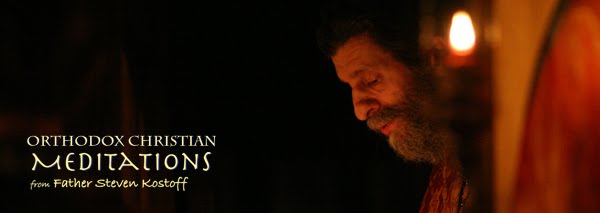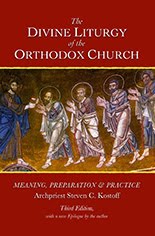Dear Parish Faithful and Friends in Christ,
"For I am sure that neither death, nor life, not angels, nor principalities, nor things present, nor things to come, nor powers, not height, nor depth, nor anything else will be able to separate us from the love of God in Christ Jesus our Lord." (Rom. 8:38-39)
I cannot find the exact citation at the moment, but I recall that St. John Chrysostom once said/wrote that, as human beings, we have three major fears: 1) poverty; 2) illness: and 3) death. And what we fear we do our utmost to avoid. We are surrounded by this fearful triad in such a way that we cannot ignore, try as we might, the dangers to our well-being that they persistently threaten us with. Poverty and illness can be thoroughly debilitating, but both can be overcome. Yet the finality of death is inescapable, and for this reason it remains the greatest of our fears, with only its postponement as our most realistic goal. For this reason, we all maximize our capabilities and strategies so as to hold these three fears at bay.
Now, as a Christian pastor, preacher and theologian, St. John went on to say that through our faith in Christ, we need to always remember that none of these three fears - or perhaps we should say "realities" - can keep us from God. The poor person can still believe in and trust God. The one who is ill can turn to God with patience and prayer. Even death itself is not a barrier between ourselves and God because the death and resurrection of Christ have removed the "sting of death," and transformed death into a passage to God.
All this leads St. John to the conclusion that there is only one thing to actually fear - and that would be sin! And for this reason: it is sin that creates the barrier that keeps us away from God. If, therefore, you come to the realization that the supreme good in life is closeness with God, then you realize that there is nothing in this world that can undermine that relationship but sin itself, that "missing of the mark" that frustrates our relationship with God. Poverty, illness and death itself cannot keep us from God, but sin can and will. Ultimately, a profoundly encouraging insight by a deep Christian thinker and pastor.
I should add that in no way did St. John brush aside the terrible effects upon living human beings of poverty, illness and the fear of death. He tirelessly preached to his flock about its responsibility to alleviate the crushing burden of poverty that others are suffering from; or to deeply sympathize and assist those who are struggling with any kind of illness or physical defect. He knew firsthand about the harsh environment of a sprawling cosmopolitan setting and how the well-to-do and healthy members of that society can coldly ignore the sufferings of others - even among his Christian flock. He knew the grip that the fear of death terrorized his same flock with. Poverty, illness and death were daily realities that he contended with when both a presbyter and then bishop in the cities of Antioch and Constantinople. All the more so, then, as a preacher would he exhort and seek to keep the image of Christ alive and burning within the minds and hearts of his flock. For St. John, only faith in Christ could dispel, or at least weaken, those fears.
As to our fears today, the same is true for us as there is "nothing new under the sun." What is different in our immediate present is just how these three fears have been so forcefully - if not brutally - brought to our attention with the spread of the coronavirus.
This global pandemic has brought these three realities to the surface in a way that most people have probably not experienced in their lives before today. Life goes on in our homes and families, but our conversations, the news that we hear, and our very thoughts are fixated on the things we are contending with - poverty, illness and death. These fears that we can more-or-less hide from within the quotidian events of "normal life" have been thrust before our troubled and anxious gaze. Unexpected unemployment is afflicting a huge segment of our society, to the point that it is being compared to some of the great recessions of the past. This raises the specter of poverty, even with the social programs and government assistance that are meant to alleviate the pressures of that possibility. We know further of how unemployment undermines self-confidence and self-worth leading to depression over the uncertainty of the future. Hence, the eagerness to re-establish normalcy so as to "get back to work." As over a million Americans have been infected with the coronavirus, and as we hear some of the horrific stories of people who have been ill, we then all the more fear our own exposure so that now our "neighbor" is the very person that must be avoided and kept at a distance. We can no longer invite other persons into our "space." And with over sixty thousand American deaths as of this writing, the reality of death is no longer a remote inevitability postponed for a far-distance future; but something brought to our attention on a daily basis. Thus, as St. John Chrysostom taught centuries ago, we are indeed facing our worst fears today.
There may exist a misplaced piety among Christians that claims that any fear in the face of any danger is somehow indicative of a lack of faith. The person who believes in Christ should be fearless, according to this approach. And there is support for such a position found in the Scriptures: "that through death he (i.e. Christ) might destroy him who has the power of death, that is, the devil, and deliver all those through fear of death were subject to lifelong bondage" (Heb. 2:14-15). A firm belief in Christ's victory over death is our path to freedom for its fearful grip.
And yet, in that same Epistle to the Hebrews, we hear of Christ's agony - and fear - in the Garden of Gethsemane in deeply moving terms: "In the days of his flesh, Jesus offered up prayers and supplications, with loud cries and tears, to him who was able to save him from death, and he was heard for his godly fear" (Heb. 5:7). Even the Son of God agonized over his messianic ministry of passing through "the valley of the shadow of death." There is apparently an inevitable tension between a stance of fearlessness before the reality of death; but also of a genuine fear of death while "in the flesh." I would think that most Christians live within that tension. Christians believe that Christ has "trampled down death by death." This is the faith that we live by and which we proclaim in our liturgical assemblies, especially when receiving the Eucharist. But we will face our own "agony" and fear when faced with the prospect of death. Perhaps we all share that poignant cry from the Gospel: "I believe, help my unbelief!" (Mk. 9:24). Those Christians who attempt to intimidate "weaker" Christians into "proving" that they have faith even when fearful, are clearly lacking in charity.
St. John Chrysostom was right: we fear 1) poverty; 2) illness; and 3) death. We can call this (fallen) human nature or the human condition. Any such terms are applicable. If our anxieties and fears have been heightened to a greater of lesser degree during this coronavirus pandemic, it need not cause us further anxiety concerning our faith, or a debilitating discouragement that we are not being faithful enough.
To see our weaknesses is not meant to discourage us. In fact, it should encourage us to be honest about ourselves, so as to face and wrestle with our fears. Perhaps like the patriarch Jacob in that mysterious event when he wrestled with an angel, that is how we can overcome them. We know our weaknesses, now we need to avail ourselves of those "tools" from within the Church which, when humbly turned to, can build up our faith: prayer, the Scriptures, Repentance, Confession and the Eucharist (when available again!). Otherwise, our social isolation will only create spiritual fatigue and emptiness. We cannot afford to wait until life returns to normal to then resume our "religious lives" in church. On the contrary, St. Paul exhorts us: "Behold, now is the acceptable time; behold now is the day of salvation" (II Cor. 6:2). And elsewhere: "I can do all things in Christ who strengthens me" (Phil. 4:13).
I believe being brought face-to-face with our fears is a painful lesson in humility. The French Orthodox theologian, Jean-Claude Larchet says this with great insight:
Illness is an opportunity for each person to experience his ontological fragility, his dependence, and to turn to God as the one who can help overcome it: if not physically (for there do occur, in response to prayer, miraculous healings), then at least spiritually, and give it a meaning by which one builds oneself up, and without which one only allows oneself to be destroyed.
To be humbled is not to be discouraged. To put that another way: I do not believe that God works through discouragement. But I do believe that strengthened by the grace of God, we can work through discouragement in any form that it may assail us. Realizing our dependence on Christ - "For apart from me you can do nothing" (Jn. 15:5) - teaches us to be humble. We therefore cannot judge anyone else - including all of those "unbelievers" who live in our midst.
There is something to learn about ourselves, the world around us, and "life" itself, as we face a multitude of fears during this coronavirus crisis in which we are immersed. The process may be painful, but the results are positive. We are learning to care for and to love each other, to more fully appreciate the "little things" in life, to take nothing for granted - including tomorrow - and to deeply sympathize with the sufferings of others.
On the pastoral level I am hoping that this includes a deeper awareness of our dependence on God. St. John Chrysostom knew our fears, but he also knew how liberating it is to believe in Christ. We may realize this today as never before: "Jesus Christ is the same yesterday, today, and for ever." (Heb. 13:8). A contemporary Orthodox theologian, Fr. John Breck, expresses this timeless Christian hope as follows:
I hope fear of the coronavirus will lead all of us to recognize "the one thing needful:" to focus eyes and heart beyond the immediate threat, and upon the beauty, peace and joy of the Kingdom of God. If our suffering enables us to "participate in Christ's own afflictions" (Col. 1), then we can look forward to physical death — however it may occur — not only as liberation, but as a very real transformation from "this body of death" to a spiritual body with eyes to contemplate forever the glorious Face of the Risen Lord.
Archpriest Steven C. Kostoff














